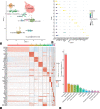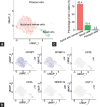Epididymis cell atlas in a patient with a sex development disorder and a novel NR5A1 gene mutation
- PMID: 35546286
- PMCID: PMC9933965
- DOI: 10.4103/aja202226
Epididymis cell atlas in a patient with a sex development disorder and a novel NR5A1 gene mutation
Abstract
This study aims to characterize the cell atlas of the epididymis derived from a 46,XY disorders of sex development (DSD) patient with a novel heterozygous mutation of the nuclear receptor subfamily 5 group A member 1 (NR5A1) gene. Next-generation sequencing found a heterozygous c.124C>G mutation in NR5A1 that resulted in a p.Q42E missense mutation in the conserved DNA-binding domain of NR5A1. The patient demonstrated feminization of external genitalia and Tanner stage 1 breast development. The surgical procedure revealed a morphologically normal epididymis and vas deferens but a dysplastic testis. Microfluidic-based single-cell RNA sequencing (scRNA-seq) analysis found that the fibroblast cells were significantly increased (approximately 46.5%), whereas the number of main epididymal epithelial cells (approximately 9.2%), such as principal cells and basal cells, was dramatically decreased. Bioinformatics analysis of cell-cell communications and gene regulatory networks at the single-cell level inferred that epididymal epithelial cell loss and fibroblast occupation are associated with the epithelial-to-mesenchymal transition (EMT) process. The present study provides a cell atlas of the epididymis of a patient with 46,XY DSD and serves as an important resource for understanding the pathophysiology of DSD.
Keywords: NR5A1; disorders of sex development; human epididymis; scRNA-seq.
Conflict of interest statement
None
Figures





References
-
- Hughes IA, Houk C, Ahmed SF, Lee PA Lawson Wilkins Pediatric Endocrine Society/European Society for Paediatric Endocrinology Consensus Group. Consensus statement on management of intersex disorders. J Pediatr Urol. 2006;2:148–62. - PubMed
-
- Nabhan ZM, Lee PA. Disorders of sex development. Curr Opin Obstet Gynecol. 2007;19:440–5. - PubMed
-
- Ohnesorg T, Vilain E, Sinclair AH. The genetics of disorders of sex development in humans. Sex Dev. 2014;8:262–72. - PubMed
-
- Pasterski V, Prentice P, Hughes IA. Impact of the consensus statement and the new DSD classification system. Best Pract Res Clin Endocrinol Metab. 2010;24:187–95. - PubMed
MeSH terms
Substances
LinkOut - more resources
Full Text Sources

